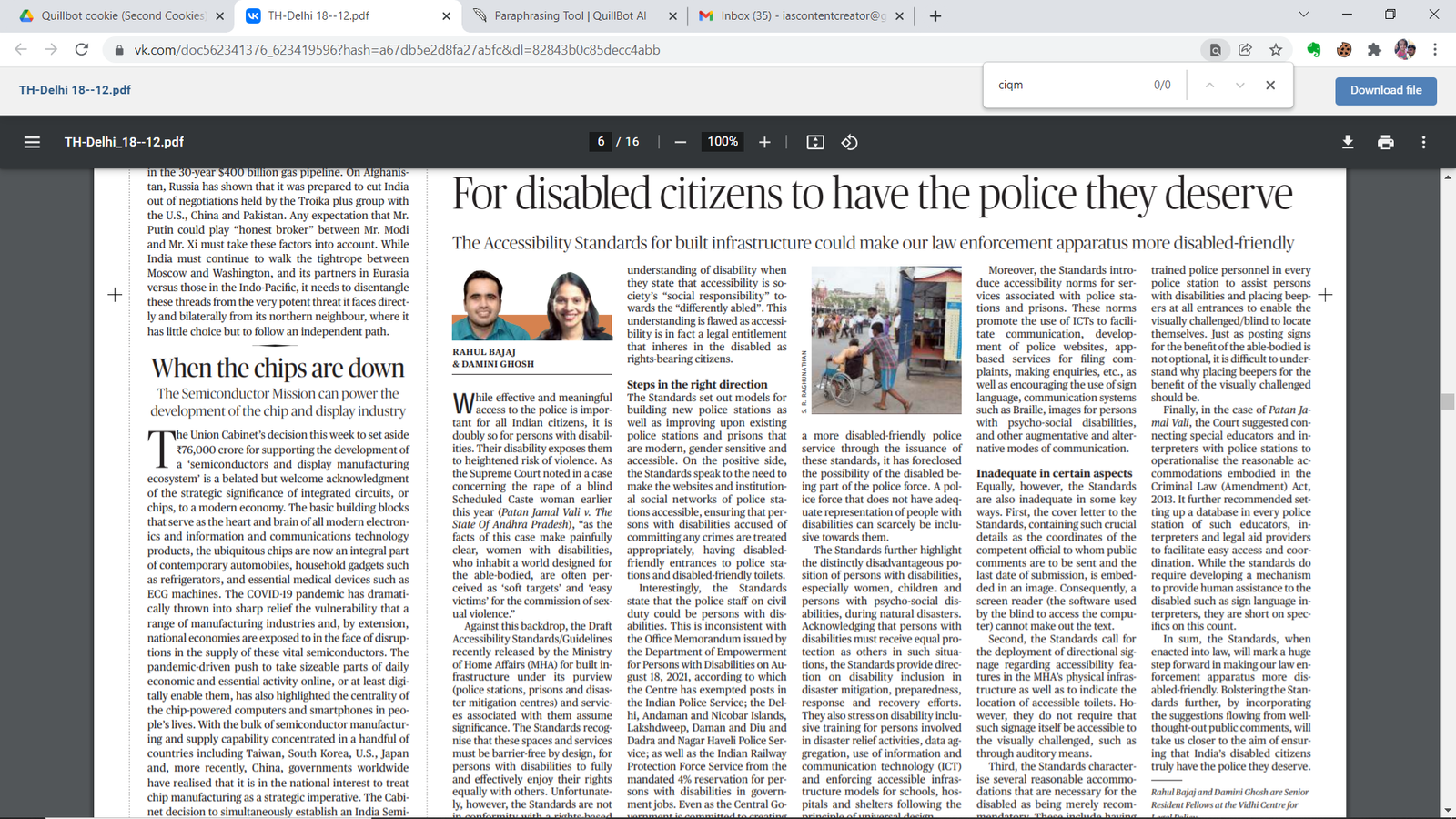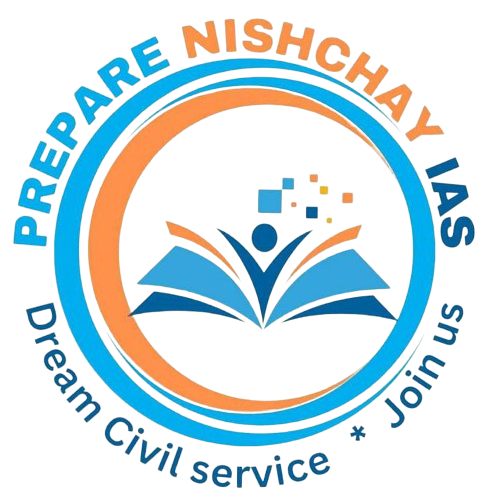
Prepare IAS Coaching
Current Affairs

Title : PERSONS WITH DISABILITIES
Date : Dec 21, 2021
Description :
Based on a News Article published in the ‘The Hindu’ on 18th December 2021 on Page Number 6
Useful for UPSC CSE Prelims and Mains (GS Paper II)
Introduction:
- Disabilities is a broad phrase that encompasses impairments, activity constraints, and participation limitations.
- An impairment is an issue with a person's physical function or structure; an activity limitation is a problem with a person's ability to do a task or action; and a participation restriction is a problem with a person's ability to participate in life events.
- According to the 2011 Census, 2.68 crore people in India are classified as "disabled," out of a total population of 121 crore (2.21 percent of the total population)
- 1.5 crore men and 1.18 crore women make up the total population of 2.68 crore.
- The majority of the disabled people (69%) lived in rural areas.
India's Constitutional Framework for Disabled People:
- Within the limits of its economic capacity and development, the state must make effective provisions for securing the right to work, education, and public assistance in cases of unemployment, old age, sickness, and disablement, according to Article 41 of the Directive Principles of State Policy (DPSP).
- The subject of'relief of the disabled and unemployable' is stated in the constitution's state list of the Seventh Schedule.
Legislative Measures:
- The Disabled Persons' Rights Act of 2016 is a set of laws that protect disabled people's rights.
- The Persons with Disabilities (Equal Opportunities, Protection of Rights, and Full Participation) Act of 1995 is repealed.
- A "person with disability" is a person who has long-term physical, mental, intellectual, or sensory impairments that, when combined with barriers, prevent him from participating fully and effectively in society on an equal footing with others.
- "Person with benchmark disability" implies a person who has not less than 40% of a specified disability that has not been defined in measurable terms, as certified by the certifying authority, and includes a person who has a disability that has been described in measurable terms.
Changes brought out in the Disabled Persons' Rights Act of 2016:
- Disability is a concept that is constantly changing and evolving.
- Respect for inherent dignity, individual autonomy, including the ability to make one's own choices, and person independence are claimed to be adopted for the empowerment of persons with disabilities (PWD).
- The principle indicates a shift in perspective on disability from a social welfare issue to a human rights concern.
- The number of infirmities has been increased from seven to twenty-one. Mental illness, autism spectrum disorder, cerebral palsy, muscular dystrophy, chronic neurological conditions, speech and language disability, thalassemia, haemophilia, sickle cell disease, multiple disabilities such as deaf blindness, acid attack victims, and Parkinson's disease were all added to the act, which had previously been largely ignored.
- In addition, the government has been given the authority to notify any other designated handicap group.
- It raises the percentage of people with disabilities who are eligible for government positions from 3% to 4% and from 3% to 5% in higher education institutions.
- Every kid between the ages of 6 and 18 who has a baseline disability has the right to a free education. Both government-funded and government-recognized educational institutions will be required to deliver inclusive education.
- Along with the Accessible India Campaign, emphasis has been placed on ensuring accessibility in public buildings within a specified time range.
- The State Commissioners and the Chief Commissioner for Persons with Disabilities will serve as regulatory bodies and grievance redressal agencies, monitoring the Act's implementation.
- To give financial assistance to people with disabilities, a separate national and state fund should be established.
- The bill calls for the District Court to provide guardianship, with the guardian and persons with disabilities working together to make decisions.
- The Office of the Chief Commissioner for Persons with Disabilities and the State Commissioners will serve as regulatory organisations and grievance redressing agencies, as well as oversee the Act's implementation.
- The bill includes penalties for crimes against people with disabilities, as well as violations of the new law's requirements.
- In each district, special courts will be established to address complaints involving violations of PwDs' rights.
- The New Act would align our laws with the United Nations Convention on the Rights of Persons with Disabilities (UNCRPD), which India has ratified.
Disabled People's Programs/Initiatives in India:
- Accessible India Campaign: Creating a Barrier-Free Environment for People with Disabilities:
- A national flagship programme aimed at attaining universal accessibility, which will allow people with disabilities to live freely and fully engage in all parts of life in an inclusive society.
- The programme aims to improve the built environment, transportation system, and information and communication ecosystem's accessibility.
- DeenDayal Disabled Rehabilitation Scheme: The scheme provides financial support to non-governmental organisations (NGOs) that provide services to people with disabilities, such as special schools, vocational training centres, community-based rehabilitation, pre-school and early intervention, and so on.
- Aid to Disabled Persons in Purchasing and Installing Aids and Appliances (ADIP): The Scheme strives to assist disabled people by providing them with appropriate, long-lasting, scientifically built, modern, standard aids and equipment.
- Fellowship for Students with Disabilities in the United States (RGMF)
- The programme aims to give individuals with impairments more possibilities to pursue higher education.
- Each year, 200 Fellowships are awarded to students with disabilities under the scheme.
- The National Trust for the Welfare of Persons with Autism, Cerebral Palsy, Mental Retardation, and Multiple Disabilities has a number of different programmes.
Problems and Obstacles:
- Health:
- Many disabilities, such as those caused by medical disorders during birth, maternal circumstances, malnutrition, and accidents and traumas, are preventable.
- However, the health sector, particularly in rural India, has failed to respond to disability in a proactive manner.
- Furthermore, there is a scarcity of cheap health care, aids, and equipment.
- Another issue with rehabilitation centres is the lack of healthcare facilities and poorly qualified health-care professionals.
- Education:
- The educational system does not cater to all students. It has been a big problem to include children with mild to moderate disabilities in conventional classrooms.
- There are a number of concerns, including the availability of special schools, school access, skilled teachers, and educational materials for the disabled.
- Furthermore, in many cases, reservations for impaired students in higher education institutions have not been honoured.
- Employment:
- Despite the fact that many impaired persons are capable of productive work, their employment rates are significantly lower than the general population.
- The situation is significantly worse in the private sector, where disabled people are far less likely to be employed.
- Physical accessibility in buildings, transit, and access to services, among other things, remains a serious concern.
- Social Exclusion/Discrimination:
- Negative attitudes held by disabled people's relatives, and often by the disabled themselves, prevent disabled people from participating fully in their families, communities, and workplaces.
- Disabled persons suffer discrimination on a daily basis. People who suffer from mental illness or mental retardation are subjected to the harshest stigma and social marginalisation.
- Data and statistics are insufficient:
- Inclusion of people with impairments is further hampered by a lack of thorough and comparable data and statistics. The following are the primary challenges with data collecting and disability measurement:
- Disabilities are difficult to define.
- Disability Data: Different applications necessitate different disability data.
- Disability is viewed as a stigma in many places/societies, hence people are hesitant to report it.
- Inclusion of disabled people is hampered by ineffective policies and programmes. Despite the fact that different acts and programmes have been enacted with the goal of empowering the disabled, their implementation faces numerous obstacles.
Next Steps:
- Prevention: It is critical to develop preventive health services and to screen all children at an early age.
- Kerala has already begun an early-warning programme. The Comprehensive Newborn Screening (CNS) programme aims to detect deficiencies in infants early and lower the state's handicap burden.
- Awareness: It is necessary to overcome stigma in order to effectively integrate people with disabilities into society.
- There should be public awareness initiatives to educate and inform the public about all types of disabilities.
- People with disabilities might share their success stories in order to instil a positive attitude in others.
- Employment: Adults with disabilities must be equipped with employable skills.
- They must be encouraged to work in the private sector.
- Improved measurement: By enhancing disability measuring, the scope of impairment in India can be better understood.
- Education: State-level education policies for children with special needs must be developed.
- Teacher training should be provided to address the needs of differently abled children and make their inclusion in conventional schools easier.
- Furthermore, additional special schools should be established, as well as instructional materials for children with special needs.
- Access: Safety measures such as road safety, residential neighbourhood safety, public transportation, and so on should be implemented.
- Furthermore, making buildings accessible to disabled people should be made a legal requirement.
- Interventions in Policy:
- More money set aside in the budget for disabled people's welfare. Disability budgeting should be done in the same way that gender budgeting is done.
- It is necessary to verify that schemes are implemented correctly. There should be effective monitoring and accountability procedures in place for public funding.
